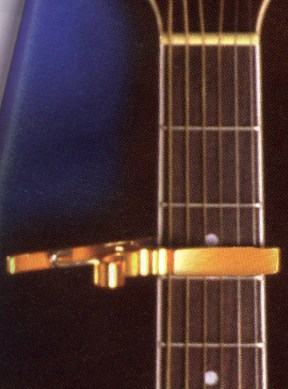Using a Capo
|
A capo is a very
useful device
especially if you're a singer. If you need to raise the key of the song
a little or a lot you just clamp it on where you need it. In
the picture at the right, the capo is placed behind the 3rd fret. This
means if you normally are playing an E major chord, now you are
actually playing a G major chord but you don't have to learn the whole
song over again to change the key.
I remember when I was trying to learn songs as a beginner I wasn't
aware of the capo and couldn't figure out certain songs.
This device is sometimes a necessity because so many other artists use
them. If you really want to learn a song and sound like the
original artist, you'll need to use one as well.
|

|
Pictured above is a Kyser capo.
I switched to using Kyser capos about 7 years ago.
They work best for 6 string guitars but I still use the
stronger clamp-on type for my 12 string.
I learn songs mostly by ear. If I have trouble learning a
song, I wait until I hear a chord in the song I recognize like a D
chord, find the D note on the D string and then put the capo on that
fret. I can do something similar if I recognize a G chord, I
find the G note on the bass E string and capo 3 frets down.
If I recognize a C chord, I find the C note on the A string and capo 3
frets down as well. Also see my Tip 106 on the
subject.
Bob, Gman ( o )==#
Hi -great website!
Wanted to pass along a tip I learned accidentally. After 25 years of
playing flute & sax, I took up guitar. I found playing jazz
tunes difficult
for a beginner like myself as they were in keys that were a bit
difficult on
guitar. One day I took out my alto sax fake book. It is set up for
instruments in
Eb. I found if you capoed at the third fret, you could play these songs
much easier. Instead of playing in Eb, Bb, or F, you now played those
same
songs in C, G, and D. What a difference! Also, my voice is not as high
as
some of these pieces are written. By taking the capo off completely, I
was
able to sing these pieces much more comfortably. I know that this may
be difficult to follow, but for those who aren't adept
at transposing, this is a huge shortcut to a vast repertory of
difficult
songs.
Thanks again for your great website.
Sincerely,
Mark Sackett
HOME
BACK TO PLAYING TIPS
